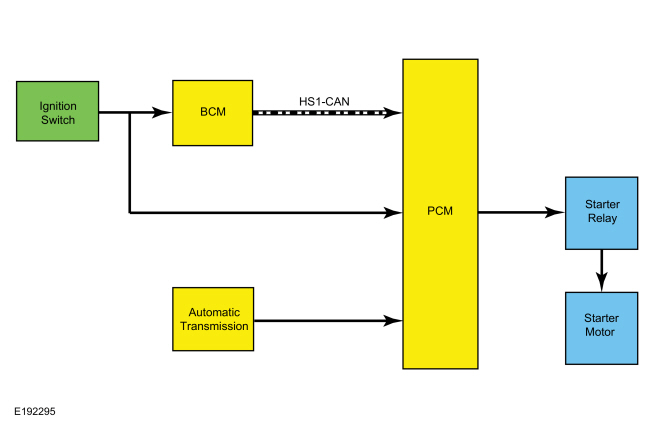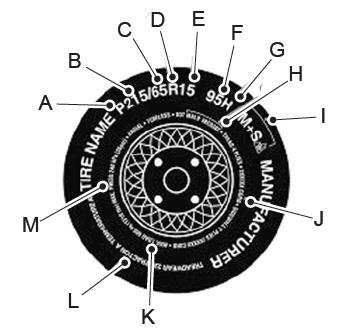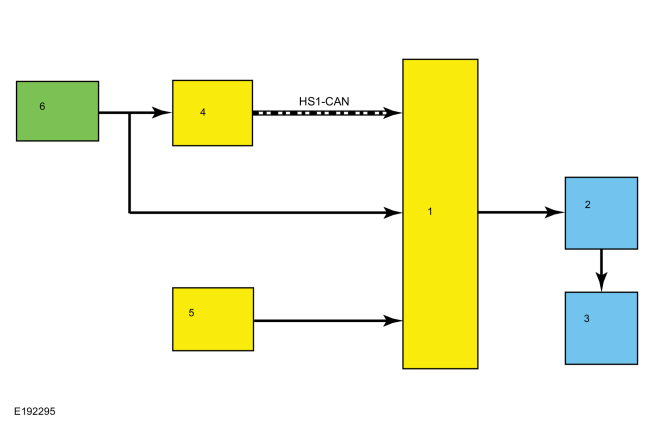Lincoln Corsair: Starting System - 2.0L EcoBoost (177kW/240PS) – MI4 / Description and Operation - Starting System - System Operation and Component Description
System Operation
System Diagram

| Item | Description |
|---|---|
| 1 | PCM |
| 2 | Starter relay |
| 3 | Starter motor |
| 4 | BCM |
| 5 | Automatic transmission |
| 6 | Ignition switch |
Network Message Chart
Module Network Input Messages Powertrain Control Module (PCM)
| Broadcast Message | Originating Module | Message Purpose |
|---|---|---|
| Starter crank request | BCM | Provides the PCM with ignition, hood input status and a request to crank and start the engine during a remote start event. |
| Remote start request | BCM | Provides the PCM with a request for remote start. |
Starting System
This vehicle is equipped with a PATS that disables the engine from
starting if an unprogrammed PATS key is used or an invalid PCM ID is
received. The PATS is controlled by the BCM . If there is a PATS concern
that disables the engine, the IPC displays the corresponding message in
the message center.
Refer to: Passive Anti-Theft System (PATS) -
System Operation and Component Description (419-01B Passive Anti-Theft
System (PATS), Description and Operation).
The BCM controls the ignition modes and, in conjunction with the PCM , the starting system.
During a start event, when the engine start/stop switch is pressed at the same time as the brake pedal, the PCM and BCM receive a request to start the engine. The PCM recognizes the correct inputs from the BCM and TR sensor and provides voltage and ground to energize the starter relay coil and close the starter relay contacts. The starter relay contacts close, providing voltage to the starter solenoid, allowing the starter motor to crank the engine. The PCM disengages the starter motor once an engine RPM threshold is reached, a set crank time is exceeded, or the start/stop button is pressed indicating an engine shutdown.
Remote Start
The remote start system is controlled by the RKE system. For more information,
Refer
to: Handles, Locks, Latches and Entry Systems - System Operation and
Component Description (501-14 Handles, Locks, Latches and Entry Systems,
Description and Operation).
Auto-Start-Stop System
The Auto-start-stop system helps reduce fuel consumption by automatically shutting off the vehicle’s engine while the vehicle is at a complete stop and restarting the engine when the brake pedal is released. The system can be disabled through the auto-start-stop control switch on the instrument panel centerstack. The Auto-start-stop system is automatically enabled whenever the ignition is turned on.
The engine automatically restarts when:
- the brake pedal is released.
- the Auto-start-stop system is disabled through the auto-start-stop control switch on the instrument panel centerstack.
- the battery has a low state of charge.
- it is necessary to maintain interior comfort.
- the blower fan speed is increased or the climate control temperature is changed.
- an electrical accessory is turned on or plugged in.
- there is low brake vacuum.
The Auto-start-stop system may not turn the engine off under these conditions:
- the HVAC system is in A/C, heat or defrost modes.
- the rear defroster is on.
- the battery has a low state of charge.
- the battery temperature is below 5°C (41°F) or above 60°C (140°F).
- the engine temperature is below 46°C (115°F).
- the engine temperature is below 60°C (140°F) and the HVAC system is in heat mode.
- the gear selector is not in Drive or Sport Mode.
- the steering wheel is turned rapidly or is at a sharp angle.
- vehicle speed of greater than 4 km/h (2.5 mph) for more than 2 seconds has not occurred.
- the vehicle is on a steep road grade.
- elevation is approximately above 3,048 meters (10,000 feet).
Refer to the Owner's Literature for additional information.
Component Description
Body Control Module (BCM)
Refer to: Module Controlled Functions - Overview (419-10 Multifunction Electronic Modules, Description and Operation).
Ignition Switch - Push Button Start
The ignition switch - push button start (engine start/stop button)
is a momentary contact switch that is hardwired to the BCM and the PCM .
The ignition switch (push button start) is used to obtain the OFF, ON
or START ignition modes. For more information,
Refer to: Steering
Wheel and Column Electrical Components - System Operation and Component
Description (211-05 Steering Wheel and Column Electrical Components,
Description and Operation).
Powertrain Control Module (PCM)
The PCM provides power and ground to the starter relay to initiate cranking of the engine.
 Description and Operation - Starting System - Overview
Description and Operation - Starting System - Overview
Starting System
The starting system controls the cranking of the engine. The PCM
energizes the starter relay when it receives inputs from the ignition
switch, automatic transmission, and the BCM ...
 Diagnosis and Testing - Starting System
Diagnosis and Testing - Starting System
Diagnostic Trouble Code (DTC) Chart
Diagnostics in this manual assume a certain skill level and knowledge of Ford-specific diagnostic practices.REFER to: Diagnostic Methods (100-00 General Information, Description and Operation)...
Other information:
Lincoln Corsair 2020-2024 Service Manual: Removal and Installation - Front Wheel Bearing and Wheel Hub
Special Tool(s) / General Equipment 204-023 (T73T-1217-A) Installer, Wheel Hub Bearing Cup 204-180 (T93P-5493-A) Remover/Installer, BushingTKIT-1993-FLMTKIT-1993-LMTKIT-1993-FM 205-138 (T80T-4000-D) Installer, Drive Pinion Bearing Cup 205-140 (T80T-4000-F) Installer, Drive Pinion Bearing Cup 205-153 (T80T-4000-W) Handle 205-480Installer, Drive Pi..
Lincoln Corsair 2020-2024 Service Manual: General Procedures - Exhaust Manifold Cleaning and Inspection
Special Tool(s) / General Equipment Feeler Gauge Cleaning Clean the exhaust manifold using a suitable solvent. Use a plastic scraping tool to clean the gasket sealing surfaces. Inspection NOTE: New exhaust manifold gaskets, studs, nuts and/or bolts must be installed when an exhaust manifold is serviced. NOTE: Use a Straightedge that is calibrated by the ..
Categories
- Manuals Home
- 1st Generation Lincoln Corsair Owners Manual
- 1st Generation Lincoln Corsair Service Manual
- Exterior Mirrors
- Remote Start Settings
- Changing a Road Wheel
- New on site
- Most important about car
Information on P Type Tires

P215/65R15 95H is an example of a tire size, load index and speed rating. The definitions of these items are listed below. (Note that the tire size, load index and speed rating for your vehicle may be different from this example.)
P: Indicates a tire, designated by the Tire and Rim Association, that may be used for service on cars, sport utility vehicles, minivans and light trucks. Note: If your tire size does not begin with a letter this may mean it is designated by either the European Tire and Rim Technical Organization or the Japan Tire Manufacturing Association. 215: Indicates the nominal width of the tire in millimeters from sidewall edge to sidewall edge. In general, the larger the number, the wider the tire. 65: Indicates the aspect ratio which gives the tire's ratio of height to width. R: Indicates a radial type tire. 15: Indicates the wheel or rim diameter in inches. If you change your wheel size, you will have to purchase new tires to match the new wheel diameter. 95: Indicates the tire's load index. It is an index that relates to how much weight a tire can carry. You may find this information in your owner’s manual. If not, contact a local tire dealer.
